Volkswagen’s Emden plant has existed in northwest Lower Saxony for decades. Nowhere else is the change to electric drives so noticeable. With new logistics, new assembly and the new ID.7, a new era begins.
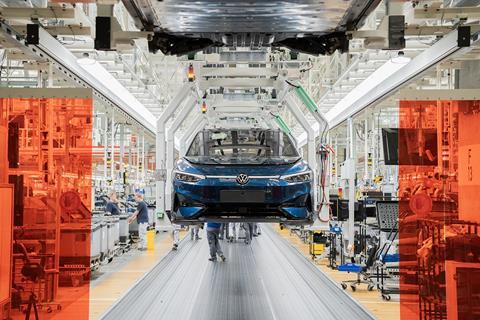
Volkswagen’s Mirko Bührmann appears to have a clear and simple order. The logistics planner has only written down three things on his shopping list: Nutella, two jars, Mett (raw pork), five portions, and hard cheese, also five portions. However, the ’supermarket’ Bührmann is shopping in is in fact his professional home – VW’s assembly plant in Emden, northwest Germany. This is where he coordinates orders for small parts.
The food items are in fact substitutes for long codes and are designed to more easily guide workers to the right shelf in the parts storage unit to find the parts they need. Bührmann is striving to ensure greater efficiency at the Emden plant by adopting a more familiar supermarket principle. At the same time, however, he is working on banning all paper shopping lists from the plant. The paperless supermarket is just one example of how VW is trying to continuously optimise its plant logistics at Emden. Bührmann’s boss, logistics manager Sebsatian Schmickartz, is visibly proud of everything that has recently happened at the Emden VW plant.

In the public perception, Emden has recently hit the headlines mainly because of a halt in production. As if the demand-related stops were not bad enough, at the beginning of the 2024 famers forced plant manager Uwe Schwartz to interrupt production by blocking roads and disrupting inbound parts deliveries. However, cars have been rolling off the production line again as normal since then, though that no longer includes the Passat, assembly of which stopped in March.
”Some employees have probably worked with the Passat all their lives. The farewell was accordingly emotional for some them,” admits Schwartz.
However, the future is electric and this is particularly noticeable in Emden. The ID.4, the ID.7 and the ID.7 Tourer are currently being built here. The Arteon Shooting Break is the last remnant of the combustion engine models but its days are also numbered and it is being quietly phased out.
Factory logistics has been turned upside down
Back to Schmickartz. He shows off the new high-bay warehouse, which was built between June 2021 and March 2023 for €42m. The goods receipt area is in Hall 9. The warehouse has a capacity for 16,000 large and 70,000 small load carriers. Schmickartz is particularly proud of the fully automated storage and retrieval, which enables goods to be processed efficiently and quickly. The automatic depalletizing and the automatic tugger train stations also contribute to the high level of efficiency. However, the biggest advantage of the new high-bay warehouse is probably the elimination of external storage areas. By centralising storage VW was able to cut out 74 daily truck trips. This not only leads to considerable cost savings, but also to a reduction in CO2 emissions by 123 tons per year. VW expects to save around €16m annually as a result.
To become independent of state-run Deutsche Bahn, VW has signed a contract with the company Smartrail, which in turn has exclusive rights to certain railway lines. From the main hub around Dresden, five trains now travel independently from eastern Germany to the northwest of the country. This alone has enabled the company to save around 26m truck kilometers since 2018. In addition, Emden has its own trailer yard with 540 metres of tracks.
The transformation of the Emden plant in numbers
VW invested around €1.3 billion in Emden for the transformation to production of vehicles based on its modular electric drive
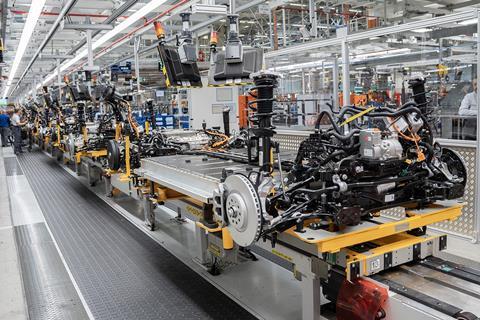
matrix (MEB). The construction of the new assembly hall took 14 months, and the first MEB vehicle rolled off the production line in December 2021. The new finishing area was completed in February 2022. The new body shop was built between March 2020 and March 2021, and the paintshop was expanded between July 2020 and September 2021. By 2030, VW aims to make the Emden plant zero carbon-emitting; currently, it emits 200,000 tonnes per year. VW wants to reduce energy requirements from 472 to 420 GWh by then. The energy required for this is to come from various sources, including:
- PV system (75 megawatts)
- Biogas/hydrogen (105 megawatts)
- Biomass (35 megawatts)
- Wind power (55 megawatts)
- Electricity mix from the VW power plant
- Battery storage
Lighting and ergonomics
When walking through the assembly area, the most striking thing is how new and bright it is. Classic metal conveyor technology, which created dark and noisy environments, has been replaced. Daylight now penetrates the rooms, and in the door pre-assembly area there is a special Human Centric Light that adjusts to the daylight. This is intended to make the shift rhythm more pleasant for the employees. The loudest noise here is almost always caused by the transport vehicles.
The suspension technology in the factory is also remarkable. While elsewhere fixed C-suspensions are often used that run on rails, here the suspensions are height-adjustable, which enables ergonomic working. The bodies can be positioned higher or lower as required. The system automatically detects the required working height and adjusts the suspensions accordingly. Each suspension is equipped with a transponder that communicates with the hall control system to ensure optimal adjustment.
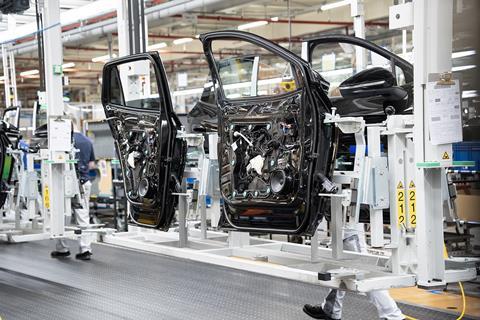
The marriage of the body and electric drive takes place relatively centrally within the assembly hall. The body is set down and slowly comes down to the level where it is screwed to the battery. The body is then pressed against the chassis from below and fixed in place before being passed on to the screwing station. The chassis screws used for this are supplied via white hoses using compressed air. Robots are used underneath to tighten the screws. The entire marriage is fully electronic and automated, tailored to the chassis and frame. Depending on the model, for example a GTX with all-wheel drive, the chassis frame varies. The system recognises the differences and adapts automatically. The current production rate is around two ID.7s and one ID.4 in alternation. The system has to adapt continuously to deliver different torques every minute. For safety reasons, there is a platform in the rear area from which a system operator can intervene in the event of problems.
Manual plugging
The wiring harness for the engine compartment is fed through the firewall and connected inside the cabin, including the battery console and fuses. Operators must attach various connectors, making sure everything is seated properly and produces an audible click. This feedback is critical to ensure the connections are correct.
“Everything has to be clipped together neatly, especially the high-voltage connections with double fuses. This makes the work more complex for the employees, but also safer, because you can no longer get to these parts after assembly,” explains production manager Georg Müller.
The worker density in assembly is high. Around two to three people are employed per cycle, and they still carry out many tasks manually, although there are also automatic screwing stations.
The electrical commissioning takes place at three stations in the hall, where each cable is checked to see if it is properly connected. If an error is discovered, the problem must be resolved before the vehicle is further assembled. In this way, Müller and his team ensure that each vehicle is in perfect condition.
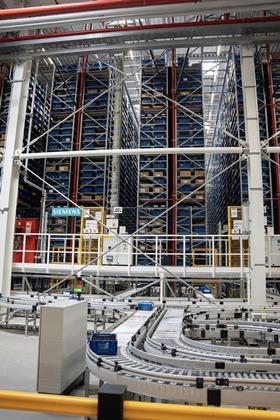
Automatic calibration of head-up displays
A special feature in the production line is equipment used to install the head-up display. This drives into the vehicle after the cockpit has already been installed. The ID.4 and ID.7 feature a head-up display that projects navigation instructions and other information onto the vehicle window. To ensure a sharp and correct image, the display must be calibrated, otherwise deviations may occur. The calibration system adjusts the head-up display. This process takes around three minutes per vehicle so a special area is kept free for it. During this time, no employee is allowed to stand in the way to ensure that the calibration runs smoothly.
At the end of each line is the control booth, home of the foreman. He has two to three teams under his wing, consisting of 10-12 people. Although there are occasional staff changes qualified personnel who can master the work processes safely are kept on-hand.
Within the teams, a rotation plan ensures that employees change every two hours to support ergonomics. Some jobs require more physical effort than others, such as those that can be carried out using an ergonomic seat.
“Securing jobs in Germany drives me. Here in Emden we want to show that you can create a competitive manufacturing location,” says Schwartz. At the end of the tour through the Emden VW plant your eyes fall on a digital display where the number “12,647,282” is written. The number describes the number of cars built at the site to date. The board is likely to evoke mixed feelings among the employees. Justified pride in what has been achieved so far is likely to be mixed with sadness about the recently redundant Passat, which is responsible for the lion’s share of the approximately 12.6m models. What other feelings will be added will depend entirely on how well plant manager Uwe Schwartz and his team manage to get the workforce in the mood for the electric ID future. Between anticipation, confidence, concern and fear, anything seems possible at the moment.
Topics
- Assembly
- Automation
- Automation
- Digitalisation
- Digitalisation and Automation
- Electrification
- Equipment
- EV manufacturing
- Industry 4 and Smart Factory
- Kaizen
- Logistics
- Manufacturing engineering
- OEMs
- Operational Excellence
- Process Improvement
- Quality
- Smart Factory
- Sustainable production
- Systems
- Training and upskilling
- Volkswagen





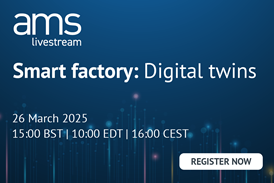






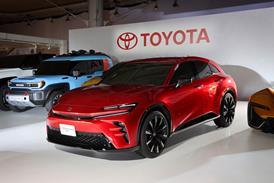

















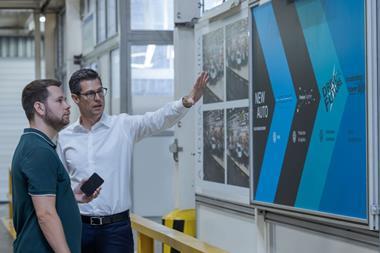


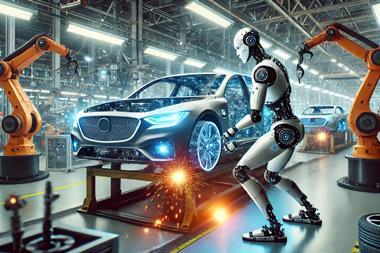




No comments yet